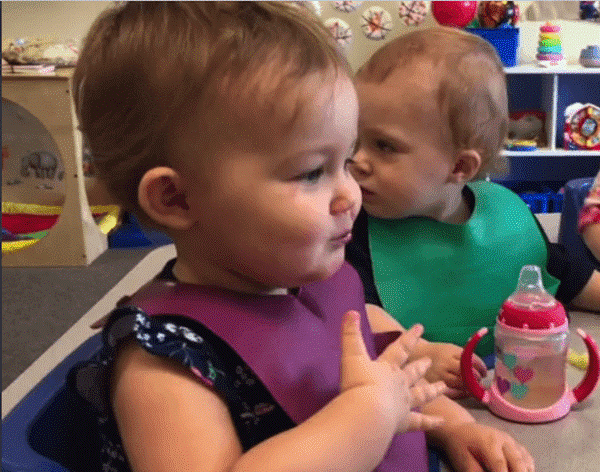- 855.224.8655
- Schedule a Tour

As a parent, how many times have you frantically asked a relative or friend, “Does that sound like a hungry cry or a painful cry?” How many times have you struggled to feed a baby who refuses more than three bites of baby food? She can’t possibly be full yet, could she? The first year of parenting can be the most challenging simply because communicating with your child is only a one-way street. If only you knew what she was trying to tell you.
Starting as early as infancy, sign language is a communication tool that many parents and teachers use to establish two-way communication with young children before they are verbal. Teaching simple signs to communicate the concepts of “hungry,” “thirsty,” “more,” or “sleepy” can help parents and caregivers understand what a child needs in that moment.
Why We Recommend Sign Language
Infants and young toddlers have the ability to understand language and develop the motor skills necessary for signing before they become verbal. Similar to how they learn to wave or clap from mimicking others, they can learn simple signs and associate them with physical objects or concepts.
Beyond the ease of communicating with your child, using toddler and infant sign language has additional developmental benefits:
- less frustration and anger results in children with greater confidence and self-esteem
- easier communication results in fewer tantrums
- signing “lessons” encourages eye-to-eye and tactile contact which can increase parent/child bonding
- since communication difficulties can often lead to behavioral problems (even as simple as shyness), these can be diminished
Many parents fear that introducing sign language will delay their child’s verbal communication. But research has shown the opposite. Introducing sign language to infants and toddlers can in fact boost speech development, increase vocabulary, and aid in mental development.
How to Introduce Toddler and Infant Sign Language
In the video below, our Toddler Room teacher demonstrates many of the simple signs that we teach to the children in our classrooms.
When To Start
Introducing sign language to your six-month-old infant on a consistent basis can result in your child being able to use sign language effectively by eight or nine months old.
Even older children can benefit from the fun and long-lasting educational impact of learning basic sign language. In an article from Parents.com, Jan Christian Hafer, Ed.D., director of general studies at Gallaudet University, explains that “three- and four-year-olds usually find signing easy and entertaining because it taps into their natural tendency to communicate using their body.”
If you’d like to learn more about how our infant or toddler curriculum and how we use sign language, contact a U-GRO learning center in your area.
